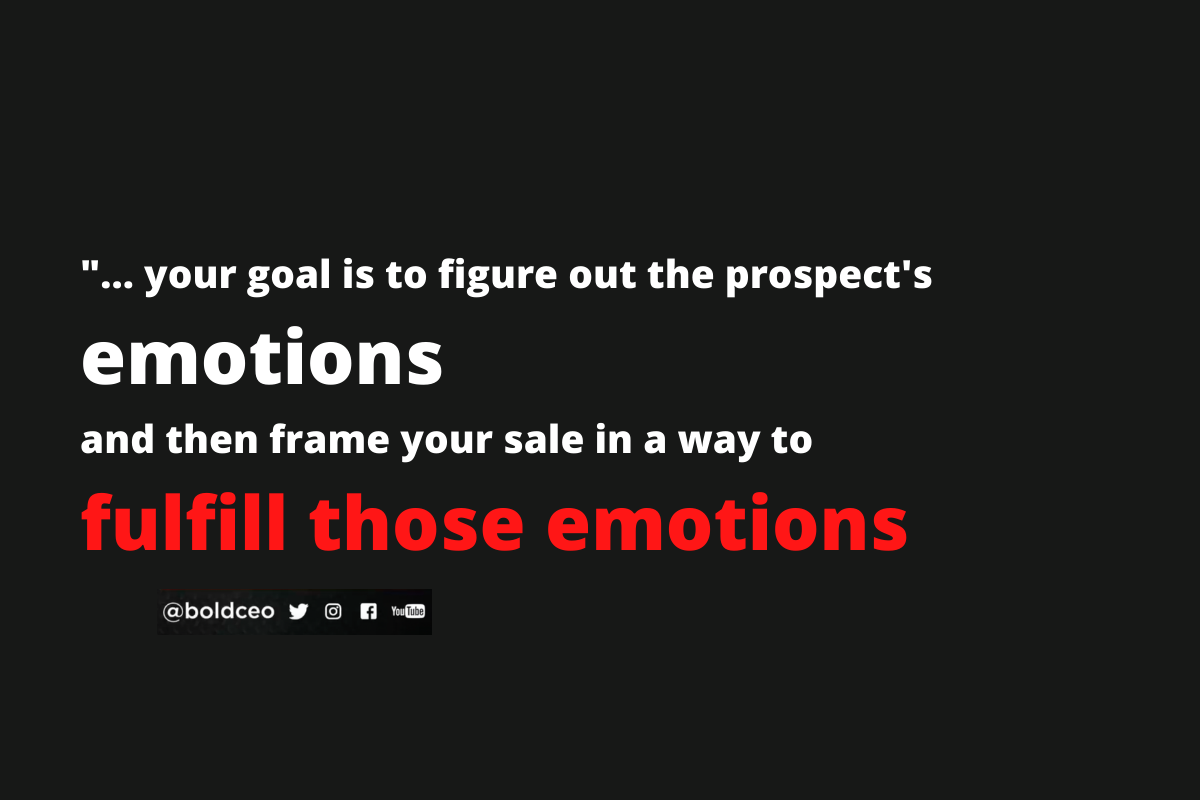Sales Negotiation Tactics Proven to Close Deals: B2B Sales Training
You and your entire sales team understand the value of your company’s vision.
Yet, at the end of every sales pitch, your prospects walk away.
If you’ve got the killer vision, the team backs it up, AND you’ve perfected your sales pipeline process, odds are that your salespeople could use sales negotiation training.
Why is having sales negotiation skills important?
Negotiating is all about uncovering what the prospects really desire, and then giving it to them in return for exactly what you want.
Knowing what the prospect truly desires, you can close the sales deal with confidence that both parties are absolutely satisfied.
If you think negotiation is all about fighting or intimidating the prospects, banish those thoughts!
The truth is, close to 100% of sales negotiation is about understanding your prospects. The better you understand them, the faster you can close sales deals.
It’s truly about helping the prospect feel good and making them realize that you are the person who can solve their problems.
Think your salespeople could use a nudge in the right direction?
Start here with these B2B sales negotiation strategies to close more deals in less time!
Negotiation Strategy 1: Study Yourself, Then Study the Prospect
In the game of winning a business deal, the first hurdle to overcome lies not in the prospect, but in yourself.
Most sales reps do not understand that they themselves are both the first and primary object standing between them and winning the deal.
Conventional wisdom says that you should begin preparing for a negotiation by studying the prospect.
But, the opposite is true.
The first step to mastering the negotiation is to master yourself and your own mind.
Once you understand yourself, you can move on to understanding the prospect.
Prepare for your sales negotiation by following these three tactics in order:
Tactic 1: Study and dislodge your own hidden assumptions
Tactic 2: Understand what you are selling
Tactic 3: Study the prospect
Lay the foundation for each sales pitch and ensuing negotiation by first going through these three tactics!

Dislodge Your Own Hidden Assumptions
How many times in your life has someone made an assumption about you before they even got to know you?
Probably more than once!
Regardless of how many times it happens though, it usually always hurts the same amount.
With that said, if you know what it’s like to have someone assume something about you, why would you assume something about somebody else, specifically your prospect?
The problem is that we think we know someone. The reality is we probably don’t know that someone.
EVERYONE has bias in them.
Those biases cause us to make assumptions about people.
However, the truth is that our assumptions about people are usually wrong, because people are more complicated than we initially think!
Even in a professional business setting, prospects are still people with the same emotional complexities that make all humans hard to interpret.
Therefore, before going anywhere, dislodge any assumptions that you may have about your prospect.
Be real with yourself! Write down any initial thoughts you have about them, and then banish them from your mind.
Master sales negotiators assume nothing and are prepared for anything. By the time you get to the sales meeting, nothing that the prospect says should surprise you because you don’t have any assumptions!
Understand What You Are Selling
If you think you are selling a genius product or service to your prospect, you are wrong!
You are selling a vision to the prospect, and the product or service is a means of delivering that vision.
Odds are that there are many other businesses out there who sell a product or service similar to yours.
But, the thing that makes your business different is the emotional vision that it attempts to create. The vision is better known as the “why” or “purpose” that the company lives by.
A vision is emotional, a product or service is not.
And, since the sales process is emotional AND prospects are emotional, you need to lace emotional appeals all throughout your pitch and ensuing negotiation.
To do that, get a better understanding of the emotional aspect of your offer by:
- Revisiting your company’s vision statement
- Reframing your pitch/sales negotiation ppt to portray your vision
- Investing your own energy into the vision
If you don’t understand what you're selling and you aren’t hyped on it either, then do that immediately! Prospects will be able to sense whether or not your enthusiasm is there.
Study The Prospect
While you should erase any fake knowledge (aka assumptions) that you have about the prospect, you shouldn’t not study the practical information about the prospect.
Practical information is not emotional!
Knowing the practical information about the prospect will make it look like you are invested in solving their problem. Not only that, but it will move you one step closer to building trust with the prospect.
Some examples of practical information include:
- The history of the prospect business
- The industry that the prospect business is in
- The names of the individuals you will be negotiating with
- How large the prospect business is
- Who the prospect’s main competitors are
DO NOT let these facts morph into emotional assumptions about the prospect.
This is basic information that will prevent a catastrophic failure, such as not knowing a stakeholder’s name, from happening during the negotiation process.
The information you gather should be simply factual, not emotional!
Use this information as mild leverage during the negotiation! There is no need to name drop, but it is useful to show the prospect that you have done some research.

Negotiation Strategy 2: Convince The Prospect That You Understand Their World
After you make your sales pitch, the real negotiating begins.
Enter sales negotiation strategy 2!
With a mind free of biases, a clear vision of your vision, and some practical information on hand, you are ready to jump into the most important part of the entire negotiation process: gathering information.
90% of negotiation success rests on extracting the right information out of the prospects.
The whole point of gathering information is to be able to view the world through the prospect's lens. And then, you can use that information to let the client know that you understand them and that they can trust you.
When you see the world through the prospect's lens, you have the chance to fulfill the true emotional desires that influence their decision making.
And, you build trust with the prospect by showing that you understand them.
Gather information from the prospects by using the following negotiation tactics:
Tactic 1: Creating an Illusion of Control
Tactic 2: Identifying their emotional state
Tactic 3: Getting them to say “no”
These three tactics will allow you to extract as much information out of the prospect as possible!
Create An Illusion of Control
So, you made your sales presentation and all of the information is on the table.
Now what?
Conventional negotiation wisdom says that this is the point where you start asking questions.
They say that asking direct questions is how you get the answers that you want.
But, that is not effective sales negotiation advice.
What is more important than asking questions is allowing the prospect to speak to give them the illusion that they are in control. When the prospect feels like they are in control, the environment is ripe to get them to start vomiting out their true desires.
Not only do you let the prospect talk, but you use your voice and body language to show your engagement.
Believe it or not, effective negotiation has less to do with what you say and more with how you say it!
Here is exactly how you give the prospect the illusion that they are in control:
- Turn the tables over to the prospect to let them speak
- Use Isopraxism
- Speak in a positive and engaging voice
First off, when you finish your presentation, kick off the sales conversation by turning the tables over to the prospects. Let them do all the talking.
Essentially, let them vomit their thoughts out onto the table while you drink in their words.
Then when they are done talking, enter the conversation by using a strategy called isopraxism.
Also known as mirroring, isopraxism is repeating the last three words of the last sentence that the prospect says in a question format.
For example, if the prospect’s final remark is, “I think our biggest challenge is curating authentic content”, you follow that up by saying, “curating authentic content?”.
When the prospect hears you mirror them, it sends a psychological signal that you want to understand them, and they feel comforted.
Once your prospect responds to your initial mirror question, mirror their response again a couple more times.
Before you know it, crucial information about their real desires will start falling out of their mouth, thanks to the mirroring.
Lastly, make sure that you have the right tone and use your body language to show that you are actively listening.
Face the decision makers head on, use a positive tone, and wait a couple of seconds in between each comment that they make before responding.
The bottom line: Kick off the process of getting the prospect to trust you by making them feel like they are in control. Then, start collecting the vital information that they vomit out as a result of the mirroring tactic.

Identify Their Emotional State
By now, the prospects should feel as if they are in control and comforted by your mirroring questions.
However, as the true sales professional that you are, you know that you are in control and that you are getting crucial information out of the prospects thanks to the mirroring tactic.
The next thing to do is to get deeper into their emotions using a tactic called labeling. Labeling is the process of figuring out the emotion driving the information they are giving you.
Remember, sales and negotiating is all about emotions. Your goal is to figure out the prospect’s emotions and then frame your sale to fulfill those emotions.
Here is how the labeling works:
- The prospect makes a statement following your mirror question
- You take a few seconds to imagine yourself in their place
- You label the emotion that you believe is behind their statements
First off, the mirror negotiation technique should have already given you some solid information about the prospect.
The goal is to get enough information out of them to get an idea of the emotions behind their words.
If you don’t feel like you have enough information yet, then ask a few more questions until you land on one that gives you a better understanding of where they are coming from.
Then, when you have information you need, pause for a moment to put yourself in their shoes.
Imagine what you would be feeling if you were in their shoes. Feel all the feels!
For example, if the prospect’s final statement is, “I don’t think our audience resonates with our existing content”, you could probably understand that they are feeling fearful of losing relevance in their field.
Whatever it is that they are saying, you just need to understand the emotion behind it.
From there, put a label on the emotion that you believe they are feeling.
If we use the example of the prospect who is worried about resonating with their audience, you can label their emotion by saying in return: “It sounds like you feel like your content isn’t portraying your brand’s true identity”.
Labeling goes like this: “It sounds/feels like you...” + the emotion you think they feel.
The most common emotions to label are negative ones related to fear, anger, and frustration.
If your prospect agrees with your label, then you can move on to the next tactic.
If they don’t agree with your label, try initiating a few more mirror statements, and then re-label.
By this point, you should have both a clear understanding of the prospect’s concerns AND a verbal confirmation that you understand their emotions. With their feelings in your hand, you are one step away from laying the deal on the table.
Get Them to Say “No” To You
The last tactic you need to employ to get the prospect to believe that you fully understand them is extremely unconventional.
This tactic became popularized by former FBI hostage negotiator, Chris Voss.
Before you dive into the nitty gritty of the deal, you need the prospect to firmly say “no” to you. In fact, you need them to say “no” several times.
Getting the prospect to say “no” does three things:
- It reaffirms their security and control in the situation
- You solidify what their emotional needs are
- You create a sense of urgency
After correctly labeling the prospect’s emotions, here is an example of how to get them to say “no”:
“Mrs. Stakeholder, do you feel like your content is getting any better?”
“No.”
“Are you willing to let your competitors dominate your content when you know your messaging is better?”
“No. And I’m ready to do what it takes to improve our content!”
“What would you like me to do to help you?”
“I want you to manage our content!”
See how getting the prospect to say “no” doesn’t corner the prospect, assures you that you know what you are talking about, and gets them heated in a good way?
Additionally, always follow-up the last “no” with an open ended question that will get them to realize that they need your help.
By this point, your prospect fully believes that you understand them, and 90% of the work is done! They like and trust you! Now, you are ready to move into the final phase of the negotiation.
Negotiation Strategy 3: Fulfill Their Emotional Needs In a Win-Win Outcome
By this point, you understand the prospect's emotions and they know it.
You are ready to fulfill their emotional needs with a sale!
At this point, you can consider things a done deal as long as you don't lose control of the remainder of the sales process.
Usually, when it comes time to talk numbers and logistics, salespeople start to crack under the pressure.
If you do that, you will show the prospect that you really don't believe in your ability to execute, and they will get cold feet.
All you need at this point is control!
There are two tactics that you need to use to gain control and close the deal:
Tactic 1: Summarizing your value
Tactic 2: Giving them a fair deal
These final two tactics will enable you to close the negotiation with a sale!
Remember, 90% of the negotiation is already over… don’t sweat things at this point!
Serve Up a Summary
By now, your prospect feels like they are on cloud 9.
They feel enthusiastic that you understand their emotions!
Now, you just need to wrap up that enthusiasm and give it to them in a tiny box.
What is in the box?
Basically, a short summary of everything that has gone down in the negotiation process so far.
Giving them a summary takes their enthusiasm beyond cloud 9 so that you can set the stage for hitting them with the hard deal!
Here is what your summary should look like:
paraphrase what the prospect has said to you in your own words + add a label on the end
That’s it. No more, no less.
Summarizing the conversation will not only boost their enthusiasm, but solidify their approval of you and give you the indication that they are ready to close the deal!
Give Them a Fair Deal
Remember, 90% of negotiation is extracting information to identify emotions.
And by now, you already have all of the information you need!
Now, you just need to put in 5 to 10% more work to solidify your pricing and other technical aspects of the deal.
In short, here is what NOT to do now: Do NOT negotiate your pricing or payment terms.
At the beginning of this article, we talked about how you and your sales team truly believe in the value of your vision.
Because you value it so much, you must hold your vision’s product or service in high regard, and come up with a fair price that reflects it.
Once you know what that fair price is, that is it.

If your prospect gawks at your conditions, remember that this truly is a win-win situation: You get the resources that you need to give them a solid deliverable, and they get the deliverable + the vision of the deliverable.
You can’t let the prospect get the deliverable and vision for less money, otherwise it is simply unfair to you and a slap in the face to your vision.
Never forget the value of your “why”!
Furthermore, if your client sees your pricing template and shivers, use one of the following negotiation tips to get them to get them to move forward:
- Frame the deal in terms of loss aversion
- Opt for a non-monetary deal
- Offer a sudden gift
First off, play to the fact that humans are loss averse, meaning that they are more reactive to losing than they are winning.
Label the negative emotion you are feeling from them, and then remind them what they will lose if they don’t take your deal.
If we go back to the case of the prospects who are losing traction on their content, make use of the fear that they have over that problem.
Remind them of what they will lose if they don’t accept your offer. Remind them that their entire platform is at stake, and that is a big loss!
All of the sudden, the prospects will realize that they have everything to gain by taking your deal and everything to lose if they don’t!
Second, if your prospect is seriously concerned about money, negotiate a non-monetary deal.
For example, offer to drop your price a certain amount in return for getting a testimonial video from them.
Whatever you do, only lower price in terms of the value of the non-monetary item you are asking for.
If you are asking for $10,000 from the client and a video testimonial is worth $900 to you, then drop your offer to no less than $9,100.
Lastly, offer your prospect a gift when they are least expecting it.
Use this tactic to break up any long or awkward pause in the conversation.
For example, if you make your offer and the prospect pauses, jump in and offer them a gift such as a free product consultation or an extra week of service at a discounted price.
You will already have the costs of those gifts baked into your offering price, but they will think that you are putting this offer out uniquely for them.
By offering the prospect a generous gift, you are using a sales psychology tactic called reciprocation.
When you offer something to someone, it is natural that they will want to reciprocate the favor in some way. In this situation, the prospect will be nudged to reciprocate by saying yes to your proposal.
Still feeling a little strung up on this last sales negotiation strategy?
If you have been following conventional wisdom about negotiation for several years now, it only makes sense!
Just remember, if you spend the majority of your time becoming more informed about the prospect, you are surely in the green.
90% of negotiation is using the information you uncover to show the prospect you understand them. Do that, and the last stretch of the game will be like cake to you. It only looks scary if you’ve never done it before.
Final Thoughts on the Top Sales Negotiation Tactics
If your sales professionals are on target to close sales deals but just need a little extra something special to level up their skills, start here with these sales negotiation tactics!
The combination of these tactics plus a complete sales training program will take your company's sales performance to new heights!
No more going through the entire sales cycle only to just miss the finish line. Cross the finish line and round the track a hundred times more with the right negotiation tactics!
You May Also Like
These Related Articles

Why Negotiating In Sales Kills More Deals Than It Saves

How to Shorten Your B2B Sales Process Down to a Few Days




